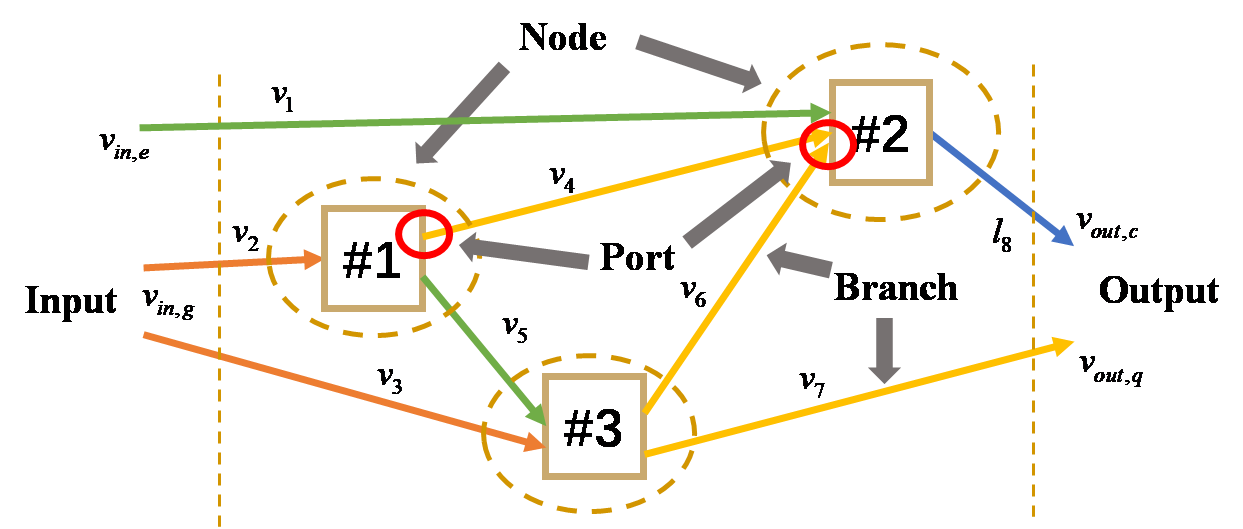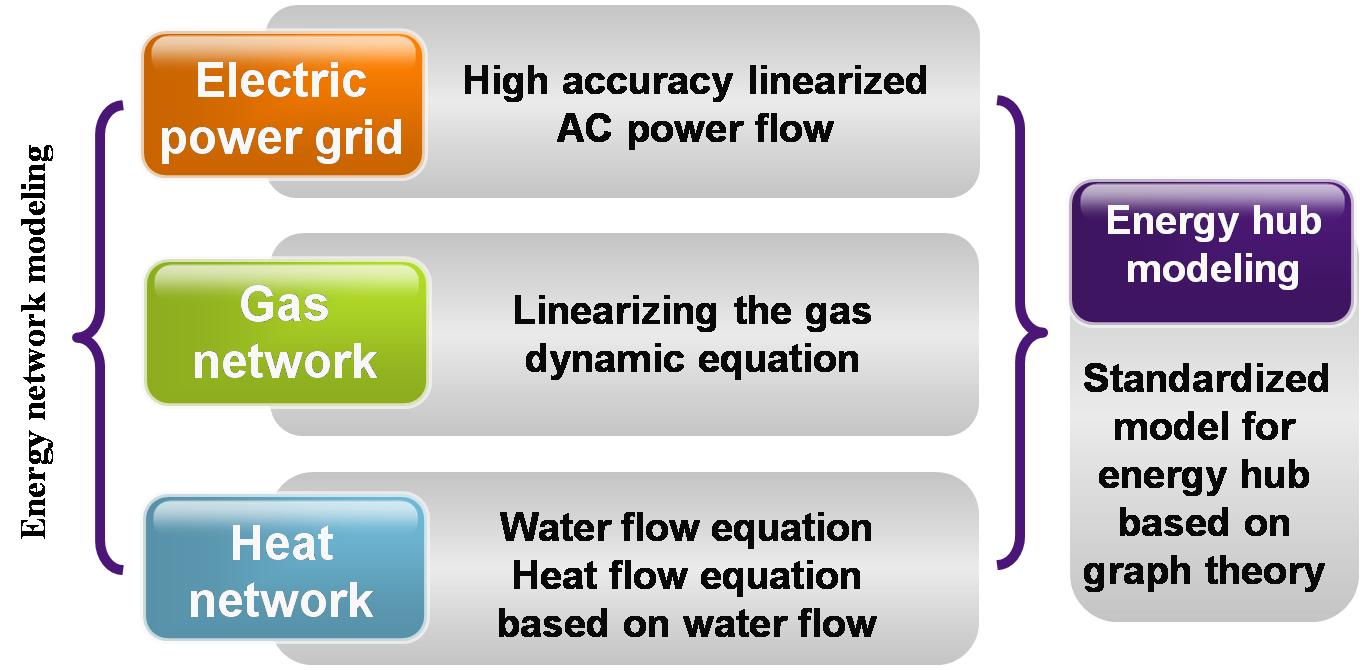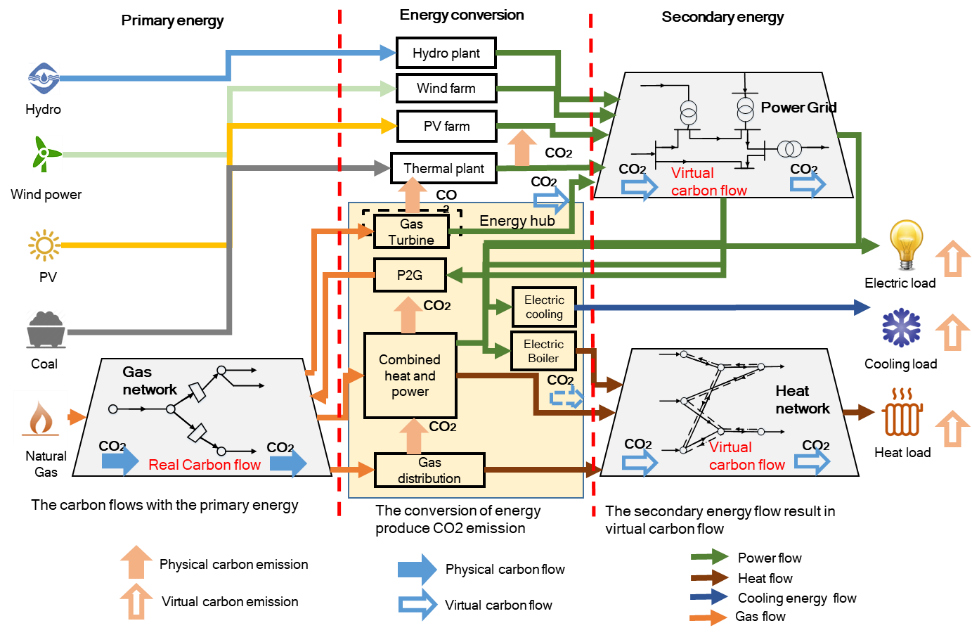Multiple Energy Systems Integration
MES denotes the integration of the generation, transmission, storage and consumption of electricity, heat, cooling and gas subsystems in modern energy systems, so as to obtain the so-called “Energy Internet”. Driven by the information and communication technology, the synergy of different energy systems enables a more smarter management of energy than operating the each kind of energy system separately. Since the energy storage is much more inexpensive in gas and heat system, MES is able to largely improve the accommodation of renewable energy by employing the flexibility of gas and heat system as economic virtual energy storage. In adddtion, MES can unlock the flexibility of shifting across multiple energy vectors and result in improved overall efficiency, reduced costs and lower emissions compared to separate energy systems.
 |
The main challenge for jointly analyzing MES is that the physical fundamental of electricity, heat, cold and gas systems are distinct. From a long history the electricity, heat, cold and gas system belongs to different utilities so that different energy systems are separately designed. There is neither mature methodology nor practical experience to adopt. We contribute to analyze energy production, conversion, storage, transmission and consumption from the perspective of MES. Specifically:
Energy hub modeling, operation and planning
 |
We propose a systematic and standardized modeling approach that facilitates the integrated planning of district MES. In the proposed methodology, a district MES is modeled as an energy hub, a unit with multiple energy input port (energy source from outside) and output ports (load). The energy conversion, storage and distribution in MES should be modeled inner the energy hub. A standardized matrix modeling is developed based on graph theory, where the characteristics of energy converters/storage and their topology are expressed in matrix form. Based on the above methodology, an optimal MES configuration planning technique is developed.
 |
Such technique is able to design the MES without priory assumptions of the topology and capacity of the energy facility as well as energy flow configuration. Therefore, we name this technique a “starting from scratch” design technique for MES. It certainly can also be applied to the MES expansion planning.
Network modeling and planning & operation of multiple energy networks
 |
We propose approximated transient and steady matrix-form gas and heat flow model that facilitates the operation and planning of multiple energy networks. The interactions between electricity, gas and heat/cooling networks are becoming more complex with the development of distributed technologies such as gas-fired units which has made power systems more vulnerable to failures in natural gas networks. The dynamic characteristics of gas and heat flow are remarkably slower than those of power flow, which should be appropriately modeled to explore its benefits for power system operation. Take transient gas flow as an example, to avoid directly applying partial differential equations overly complicates the already complicated generation scheduling problem, we propose an approximated transient matrix-form gas flow model. We successfully avoid the nonlinearity of gas flow constraints by developing a new solution methodology. The proposed matrix-form transient model of a gas network is further applied in robust generation scheduling model considering the dynamic security constraints of gas networks. We also propose approximated steady matrix-form gas and heat flow model for jointly planning of multi-energy networks and EHs.
Low carbon of multiple energy system integration
 |
We propose a novel analytical model for carbon emission flow (CEF) in MES to quantify the carbon emission associated with the energy delivery and conversion process. The embedded carbon emission in MES is coupled among the energy flow across different energy systems. The understanding of how the embedded carbon emission should be allocated along with the energy delivery and conversion is significant in the policy making and market design to facilitate the carbon emission reduction. In the proposed model, the explicit CEF models for different energy networks, including the power network, gas network and heating network, and energy converters are established. The CEF model for an energy hub (EH) is further formulated to analyze the flow of carbon emission across different energy systems during the conversion process. Furthermore, we use the CEF model to allocate the overall carbon emission cap among district MES from the consumption-based perspective and to coordinate the planning and dispatch of the district level and the multi-regional level MES.
Related Publications:
Fangyuan Si, Ning Zhang, Yi Wang, Peng-Yong Kong, Wenjie Qiao, Distributed optimization for integrated energy systems with secure multi-party computation. IEEE Internet of Things Journal. accepted, in press. “Link”
Tian Xia, Yaowang Li, Ning Zhang, Chongqing Kang, Role of compressed air energy storage in urban integrated energy systems with increasing wind penetration, Renewable and Sustainable Energy Reviews, 2022, 160, 112203. “Link”
Wujing Huang, Xi Zhang, Kangping Li, Ning Zhang, Goran Strbac and Chongqing Kang, Resilience oriented planning of urban multi-energy systems with generalized energy storage sources, IEEE Transactions on Power Systems, 2022, 37(4): 2906-2918. “Link”
Wujing Huang, Ershun Du, Tomislav Capuder, Xi Zhang, Ning Zhang, Goran Strbac, and Chongqing Kang*, Reliability and Vulnerability Assessment of Multi-Energy Systems: An Energy Hub Based Method. IEEE Transactions on Power Systems, 2021, 36(5), 3948-3959. “Link”
Tian Xia, Wujing Huang, Xi Lu, Ning Zhang, Chongqing Kang, Planning District Multiple Energy Systems Considering Year-Round Operation, Energy, 2020, 118829. “Link”
Wujing Huang, Ning Zhang, Yaohua Cheng, Jingwei Yang, Yi Wang, Chongqing Kang. Multienergy Networks Analytics: Standardized Modeling, Optimization and Low Carbon Analysis. Proceedings of IEEE. 2020, 108(9): 1411 - 1436. “Link”
Wujing Huang, Ning Zhang, Yi Wang, Tomislav Capuder, Igor Kuzle, and Chongqing Kang*, Matrix Modeling of Energy Hub with Variable Energy Conversion Efficiencies, International Journal of Electrical Power & Energy Systems, 2020, 119: 105876. “Link”
Yaohua Cheng, Ning Zhang, Daniel S. Kirschen, Wujing Huang, Chongqing Kang. Planning multiple energy systems for low-carbon districts with high penetration of renewable energy: An empirical study in China. Applied Energy, 2020, 261: 114390. “Link”
Wujing Huang, Ning Zhang, Chongqing Kang, Tomislav Capuder, Ninoslav Holjevac, Igor Kuzle, Beijing subsidiary administrative center multi-energy systems: an optimal configuration planning, Electric Power Systems Research 179 (2020) 106082. “Link”
Yaohua Cheng, Ning Zhang, Baosen Zhang, Chongqing Kang, Weimin Xi and Mengshuang Feng, Low-Carbon Operation of Multiple Energy Systems Based on Energy-Carbon Integrated Prices, IEEE Transactions on Smart Grid,vol. 11, no. 2, pp. 1307-1318, March 2020, doi: 10.1109/TSG.2019.2935736., “Link”.
Jingwei Yang, Ning Zhang, Audun Botterud and Chongqing Kang, On an Equivalent Representation of the Dynamics in District Heating Networks for Combined Electricity-Heat Operation, IEEE Transactions on Power Systems. 2020, 35(1): 560-570. “Link”
Jingwei Yang, Ning Zhang, Audun Botterud, Chongqing Kang. Situation awareness of electricity-gas coupled systems with a multi-port equivalent gas network model, Applied Energy, 2020, 258: 114029. “Link”
Wujing Huang, Ning Zhang, Chongqing Kang Tomislav Capuder, Ninoslav Holjevac, Igor Kuzle, Beijing subsidiary administrative center multi-energy systems: an optimal configuration planning, Electric Power Systems Research 179 (2020) 106082. “Link”
Yaohua Cheng, Ning Zhang, Daniel S. Kirschen, Wujing Huang, Chongqing Kang. Planning multiple energy systems for low-carbon districts with high penetration of renewable energy: An empirical study in China. Applied Energy, 2020, 261, 114390. “Link”
Ning Zhang, Jiangnan Cheng, Yi Wang, Probabilistic Optimal Energy Flow of District Multi-energy Systems: An MPLP-based Online Dictionary-Learning Approach. IEEE Transactions on Industrial Informatics, 2019, 15(9):4867-4877. “Link”
Wujing Huang, Ning Zhang, Chongqing Kang, Mingxuan Li and Molin Huo. From demand response to integrated demand response: review and prospect of research and application. Protection and Control of Modern Power Systems, 2019, 4(4): 148-150.“Link”
Daniel Julius Olsen, Ning Zhang, Chongqing Kang, Miguel A. Ortega-Vazquez and Daniel S. Kirschen. Planning Low-Carbon Campus Energy Hubs, IEEE Transactions on Power Systems, 2019, 34(3):1895-1907. “Link”
Jingwei Yang, Ning Zhang, Yaohua Cheng, Chongqing Kang and Qing Xia. Modeling the Operation Mechanism of Combined P2G and Gas-fired Plant with CO2 Recycling, IEEE Transactions on Smart Grid, 2019, 10(1): 1111-1121. “Link”
Yaohua Cheng, Ning Zhang, Yi Wang, Jingwei Yang, Chongqing Kang and Qing Xia. Modeling Carbon Emission Flow in Multiple Energy Systems, IEEE Transactions on Smart Grid, 2019, 10(4):3562-3574. “Link”
Yaohua Cheng, Ning Zhang, Zongxiang Lu and Chongqing Kang. Planning Multiple Energy Systems towards Low-Carbon Society: A Decentralized Approach, IEEE Transactions on Smart Grid, 2019, 10(5):4859-4869. “Link”
Wujing Huang, Ning Zhang, Jingwei Yang, Yi Wang and Chongqing Kang. Optimal Configuration Planning of Multi-Energy Systems Considering Distributed Renewable Energy, IEEE Transactions on Smart Grid, 2019, 10(2):1452-1464. “Link”
Yi Wang, Ning Zhang, Chongqing Kang, Daniel S. Kirschen, Jingwei Yang and Qing Xia. Standardized matrix modeling of multiple energy systems, IEEE Transactions on Smart Grid, 2019, 10(1):257-270. “Link”
Yi Wang, Jiangnan Cheng, Ning Zhang and Chongqing Kang. Automatic and linearized modeling of energy hub and its flexibility analysis, Applied Energy, 2018, 211: 705-714. “Link”
Yi Wang, Ning Zhang, Zhenyu Zhuo, Chongqing Kang and Daniel Kirschen. Mixed-integer linear programming-based optimal configuration planning for energy hub: Starting from scratch, Applied Energy, 2018, 210: 1141-1150. “Link”
Jingwei Yang, Ning Zhang, Chongqing Kang and Qing Xia. Effect of Natural Gas Flow Dynamics in Robust Generation Scheduling under Wind Uncertainty, IEEE Transactions on Power Systems, 2018, 33(2): 2087-2097. “Link”
Jianqiang Miao, Ning Zhang, Chongqing Kang, Jianxiao Wang, Yi Wang and Qing Xia. Steady-state power flow model of energy router embedded AC network and its application in optimizing power system operation, IEEE Transactions on Smart Grid, 2018, 9(5): 4828-4837. “Link”
Yaohua Cheng, Ning Zhang and Chongqing Kang. Carbon emission flow: from electricity network to multiple energy systems, Global Energy Interconnection, 2018, 1(4):500-506.
Yaohua Cheng, Ning Zhang and Chongqing Kang. Low-carbon economic dispatch for integrated heat and power systems considering network constraints, Journal of Engineering, 2017, 2017(14): 2628-2633. “Link”
Ning Zhang, Xi Lu, Michael B. McElroy, Chris P. Nielsen, Xinyu Chen, Yu Deng and Chongqing Kang. Reducing curtailment of wind electricity in China by employing electric boilers for heat and pumped hydro for energy storage, Applied Energy, 2016, 184: 987-994. “Link”